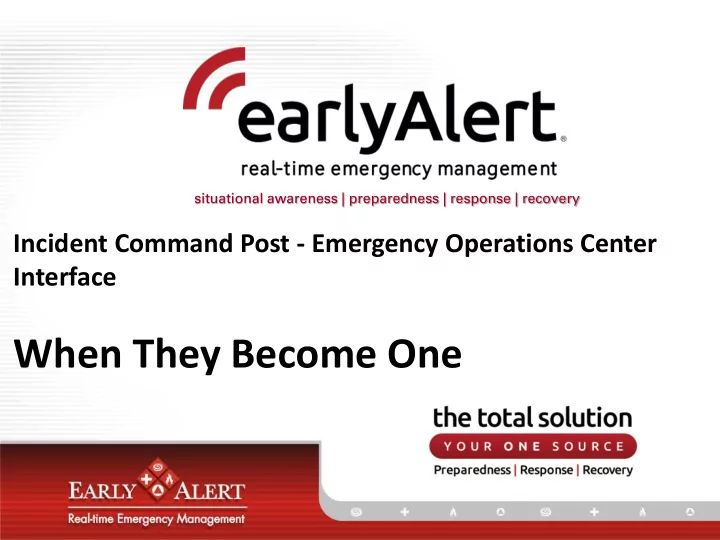

situational awareness | preparedness | response | recovery Incident Command Post - Emergency Operations Center Interface When They Become One
The purpose of this presentation is provide emergency management professionals at all levels with the knowledge and skills they need to: • Operate in the ICS-ESF model • Effectively manage an incident by providing both command and coordination • Know when one trumps the other
What actions do effective EOC’s successfully perform?
Qualified personnel Maintain accurate Situational Awareness and a Common Operating Picture Understand their role of support & coordination Prioritize critical resources Effectively disseminate pertinent, accurate, and timely information to the public Adequate and efficient organizational structure and staffing
• Provides expanded EOC guidance based on input from local, state, tribal and territorial EOC leaders • Describes common functions and terminology for staff in Emergency Operations Centers (EOC), while remaining flexible to allow for differing missions, authorities, and resources of EOCs across the Nation • Explains the relationship among Incident Command Structure (ICS), Emergency Operation Centers (EOCs), and senior leaders/ policy groups (Multiagency Coordination Group) • Enhances guidance on information management processes
• EOCs are locations where staff from multiple agencies assemble to provide coordinated support to incident command, on-scene personnel, and/or other EOCs. • The purpose, authorities, and composition of the teams that staff EOCs vary widely, but generally, the teams consolidate and exchange information, support decision making, coordinate resources, and communicate with personnel on scene and at other EOCs. • NIMS 2017 identifies three common ways of organizing EOC Teams: 1. ICS or ICS-like structure 2. Incident Support Model structure 3. Departmental structure
EOC Structures (1 of 3) ICS or ICS-like EOC Structure EOC DIRECTOR PUBLIC INFORMATION OFFICER FINANCE/ OPERATIONS PLANNING LOGISTICS ADMINISTRATION COORDINATION COORDINATION COORDINATION COORDINATION SECTION SECTION SECTION SECTION Many jurisdictions/organizations configure their EOCs using the standard ICS organizational structure. The structure is familiar to many people, and it aligns with the on-scene incident organization.
EOC Structures (2 of 3) Incident Support Model (ISM) EOC Structure EOC DIRECTOR PUBLIC INFORMA TION OFFICER SITUA TIONAL PLANNING RESOURCES CENTER AWARENESS SUPPORT SUPPORT SUPPORT SECTION SECTION SECTION SECTION Jurisdictions/organizations that focus their EOC team’s efforts on information, planning, and resource support may choose to separatethe situational awareness function from planning and combine operations and logistics functions into an incident support structure.
EOC Structures (3 of 3) Departmental EOC Structure Emergency Manager Department of Department of Department of Department of Department of Department of Natural Health & Human Public Works Administration Education Public Safety Resources Services Jurisdictions/organizations may opt instead to use their day-to-day departmental/agency structure and relationships in their EOC. By operating in the context of their normal relationships, department/agency representatives can function in the EOC with minimal preparation or startup time.
ESF1 Transportation ESF2 Communications ESF3 Public Works and Engineering ESF4 Firefighting ESF5 Emergency Management ESF6 Mass Care, Housing, and Human Services ESF7 Resources Support ESF8 Public Health and Medical Services ESF9 Urban Search and Rescue ESF10 Oil and Hazardous Materials Response ESF11 Agriculture and Natural Resources ESF12 Energy ESF13 Public Safety and Security ESF14 Long-term Community Recovery and Mitigation ESF15 External Affairs
What qualities does an effective ICP look like?
Qualified personnel Maintain accurate Situational Awareness and a Common Operating Picture Understand their role of command & control Pertinent, accurate, and timely information to the public/stakeholders Make critical resource needs known Efficient organizational structure and staffing
ICP EOC EMERGENCY DISPATCH CENTER INCIDENT ON-SCENE COMMANDER INCIDENT UNIFIED COMMAND COMMANDER DEPUTY INCIDENT Figure 2-3 COMMANDER Expanded ICS Organization FACILITY SAFETY OFFICER INFORMATION OFFICER PROCESS HUMAN RESOURCE OFFICER SAFETY OFFICER SECURITY OFFICER LIAISON OFFICER INCIDENT SAFETY OFFICER PRODUCTION AND FINANCE AND PLANNING LOGISTICS OPERATIONS RECOVERY ADMINISTRATION SECTION CHIEF SECTION CHIEF SECTION CHIEF SECTION CHIEF SECTION CHIEF
Have you experienced co-located command & coordination? What are some of the advantages? What are some of the challenges?
Advantages: Improved information flow Improved coordination Incident Management Team integration Situational Awareness/Common Operating picture maintained ESF staffing
Challenges: Adequate facility to support both Command/coordination lines crossed (stay in your lane) Policy Group and EOC personnel making command decisions Command influence on acquiring resources when they are needed elsewhere
Where do you start? 1. Incident Priorities: LIP 2. Policy Group Priorities 3. Realistic expectations 4. Resources 5. Cost 6. When in doubt: See #1
Common pitfalls: Ineffective communications between ICP and EOC Lack of Situational Awareness/C.O.P. Ineffective resource coordination Inefficient use of resources Incident Management Teams requested late in the incident
2017 Hurricane Season: EOC and Policy Group made tactical decisions Lack of effective resource ordering and tracking Not enough qualified personnel to sufficiently staff EOC EOC could not communicate effectively with command level
2017 Hurricane Season: EOC Lack of effective resource ordering and tracking Not enough qualified personnel to sufficiently staff EOC EOC could not communicate effectively with command level
Questions? Comments?
Recommend
More recommend